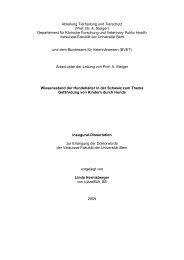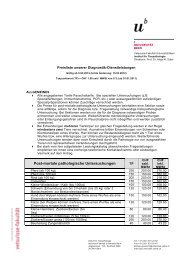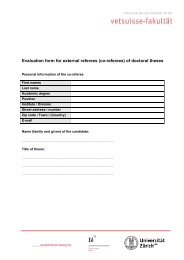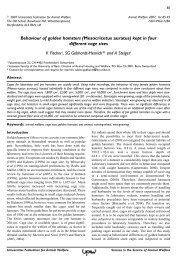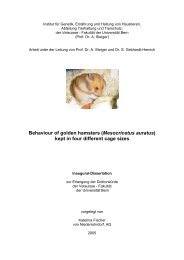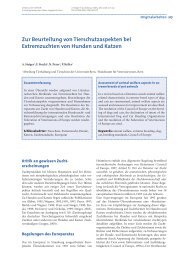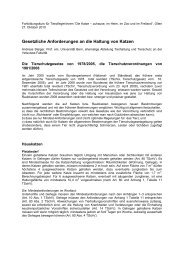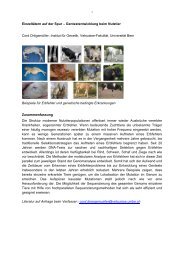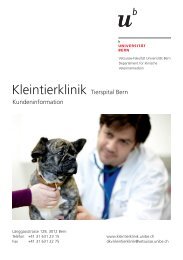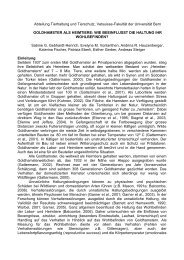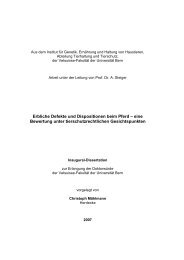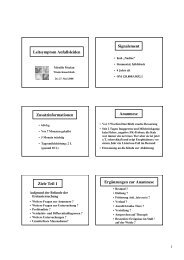Lifespan and Causes of Death in the Irish Wolfhound - Vetsuisse ...
Lifespan and Causes of Death in the Irish Wolfhound - Vetsuisse ...
Lifespan and Causes of Death in the Irish Wolfhound - Vetsuisse ...
Create successful ePaper yourself
Turn your PDF publications into a flip-book with our unique Google optimized e-Paper software.
4.2.2 The SAS Program Package<br />
Statistical analyses were performed <strong>in</strong> The SAS System ® Version 8.02. Graphs were<br />
created us<strong>in</strong>g The SAS System (boxplots) <strong>and</strong> Micros<strong>of</strong>t Excel (all o<strong>the</strong>r graphs). A<br />
probability level <strong>of</strong> p ≤ 0.05 was considered statistically significant.<br />
Statistical tests used <strong>in</strong>cluded chi-square <strong>and</strong> Fisher's exact test for categorical<br />
distributions (PROC FREQ). Analyses <strong>of</strong> variance as well as regression analyses<br />
were performed with PROC GLM.<br />
The SAS System was also used for data management, notably for convert<strong>in</strong>g <strong>the</strong><br />
Micros<strong>of</strong>t Excel Spreadsheets derived from PedX <strong>in</strong>to a form that <strong>the</strong> PEDIG<br />
applications were able to read.<br />
4.2.3 PEDIG<br />
PEDIG is a freely available FORTRAN program package that can be used for <strong>the</strong><br />
analysis <strong>of</strong> large amounts <strong>of</strong> pedigree data (Boichard, Maignel et al. 1997). In this<br />
study, Meuwissen's Inbreed<strong>in</strong>g Coefficients were calculated with <strong>the</strong> "meuw.exe"<br />
program <strong>of</strong> <strong>the</strong> PEDIG package, while <strong>the</strong> calculations <strong>of</strong> ancestor analyses<br />
(probabilities <strong>of</strong> gene orig<strong>in</strong>s) were performed us<strong>in</strong>g <strong>the</strong> "prob_orig.exe" program.<br />
The prob_orig.exe program computes <strong>the</strong> probabilities <strong>of</strong> gene orig<strong>in</strong> for a userdef<strong>in</strong>ed<br />
population <strong>of</strong> <strong>in</strong>dividuals over a user-def<strong>in</strong>ed number <strong>of</strong> generations. These<br />
probabilities are comb<strong>in</strong>ed all toge<strong>the</strong>r to estimate an effective number <strong>of</strong> founders.<br />
The program <strong>the</strong>n calculates <strong>the</strong> non-zero contributions <strong>of</strong> each founder to <strong>the</strong><br />
studied population.<br />
prob_orig.exe was used to study <strong>the</strong> differences <strong>in</strong> contribution <strong>of</strong> different founders<br />
to populations <strong>of</strong> dogs known to have suffered from a certa<strong>in</strong> disease <strong>and</strong> dogs <strong>in</strong> a<br />
reference population. If <strong>the</strong>se diseases are hereditary, it can be expected that<br />
marked founder differences between <strong>the</strong> affected <strong>and</strong> reference populations should<br />
result from this approach.<br />
To def<strong>in</strong>e a reference population for animals suffer<strong>in</strong>g from a certa<strong>in</strong> disease, 20<br />
animals <strong>of</strong> identical year <strong>of</strong> birth <strong>and</strong> country <strong>of</strong> orig<strong>in</strong> per affected case were<br />
r<strong>and</strong>omly selected from <strong>the</strong> overall database. Affected animals were excluded from<br />
<strong>the</strong> sampl<strong>in</strong>g data. R<strong>and</strong>om selection <strong>of</strong> <strong>in</strong>dividuals was achieved by us<strong>in</strong>g r<strong>and</strong>om<br />
numbers generated by <strong>the</strong> RANDOM procedure <strong>in</strong> Micros<strong>of</strong>t Excel.<br />
The calculations with prob_orig.exe were executed under <strong>the</strong> assumption that <strong>the</strong>re<br />
was only one gender (unisex). After <strong>the</strong> calculations, <strong>the</strong> correct genders were reassigned<br />
to <strong>the</strong> important ancestors for evaluation.<br />
53



